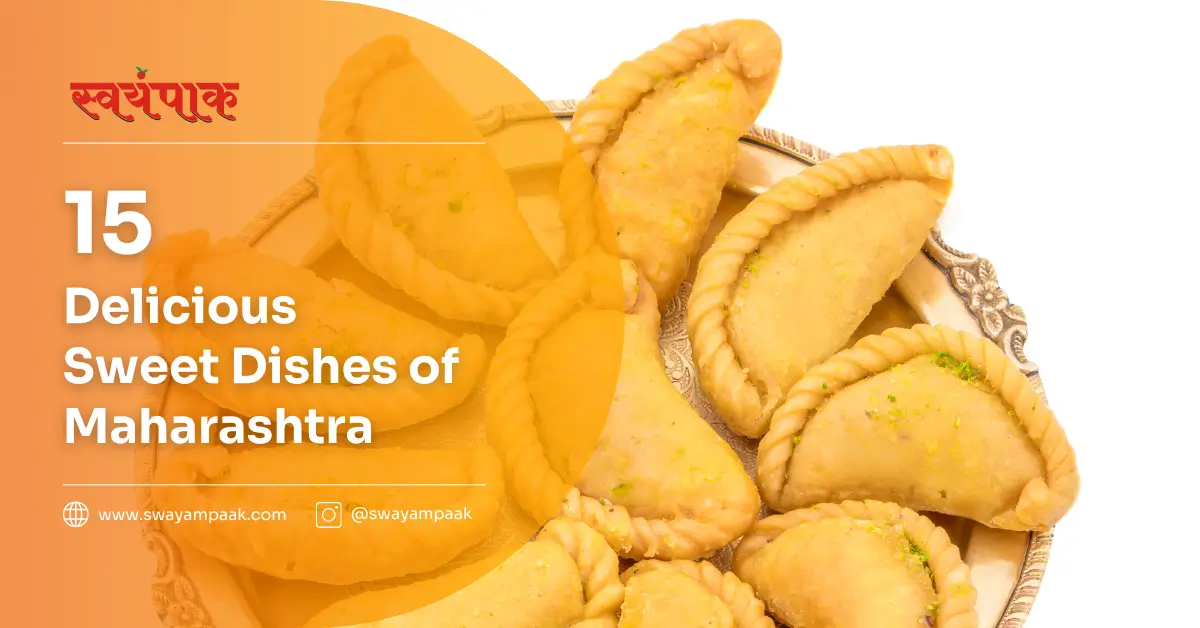Maharashtra, the land of diverse cultures and rich culinary traditions is known for its delectable sweet dishes. From traditional recipes passed down through generations to innovative creations inspired by regional flavours, Maharashtra offers a wide range of sweet treats that cater to every palate.
In this article “Sweet Dishes of Maharashtra”, we will take you on a culinary journey through the sweet dishes of Maharashtra, exploring their origins, ingredients, and the festivals they are associated with. Whether you have a sweet tooth or simply enjoy exploring different cuisines, this guide will give you a glimpse into the delightful world of Maharashtra’s sweet dishes.
In a traditional Maharashtrian thali, along with the dal, rice, kadhi, bhaaji, lonche [pickles], bhaje/pakore, desserts are a must for any festive occasion. So, what are the most loved and famous sweet dishes of Maharashtra, let’s find out.
- Introduction to sweet dishes of Maharashtra
- Traditional sweet dishes of Maharashtra
- Famous sweets from different regions in Maharashtra
- Ingredients used in sweet dishes of Maharashtra
- Popular festivals and their associated sweet dishes
- Unique and lesser-known sweet dishes of Maharashtra
- Famous sweet shops in Maharashtra
- Sweet dishes of Maharashtra: Make At Home
- Health benefits of sweet dishes of Maharashtra
- Conclusion
Introduction to sweet dishes of Maharashtra
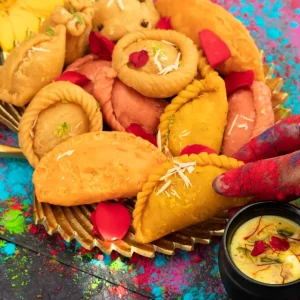
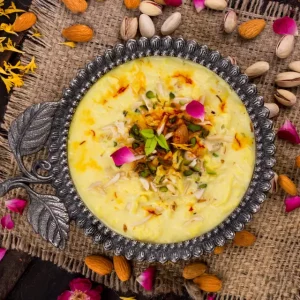
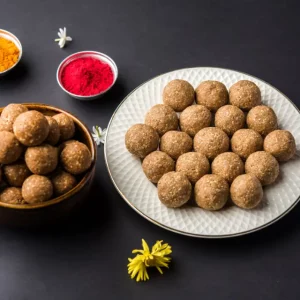
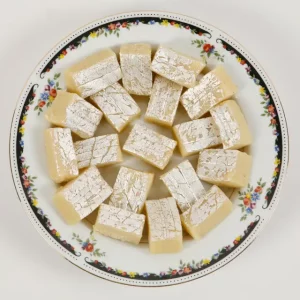
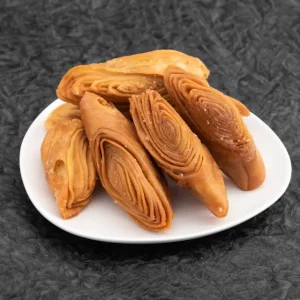

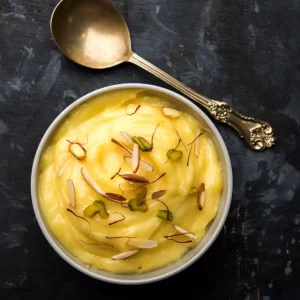
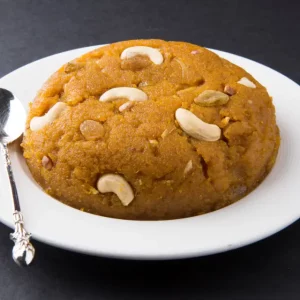
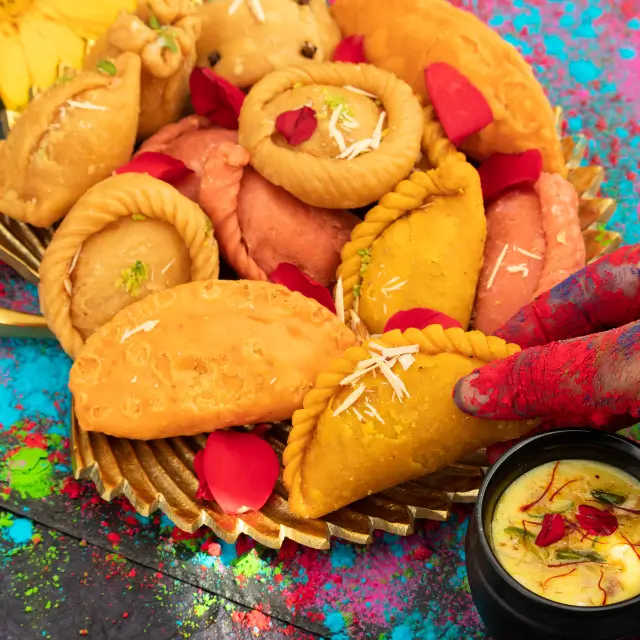
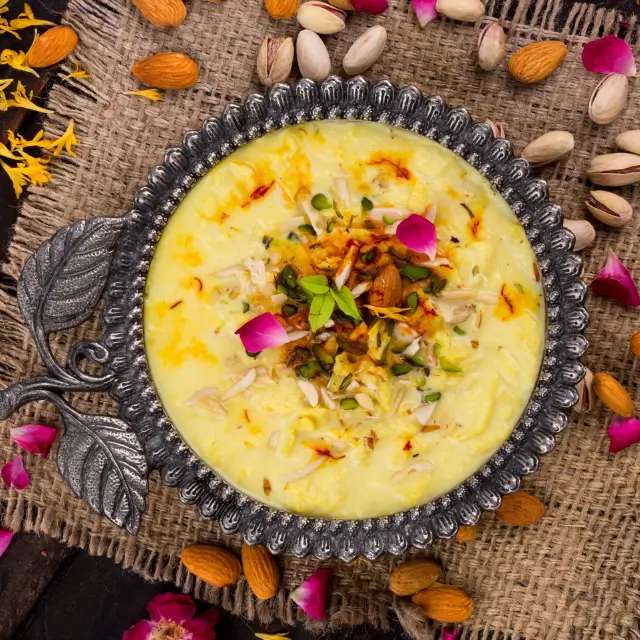
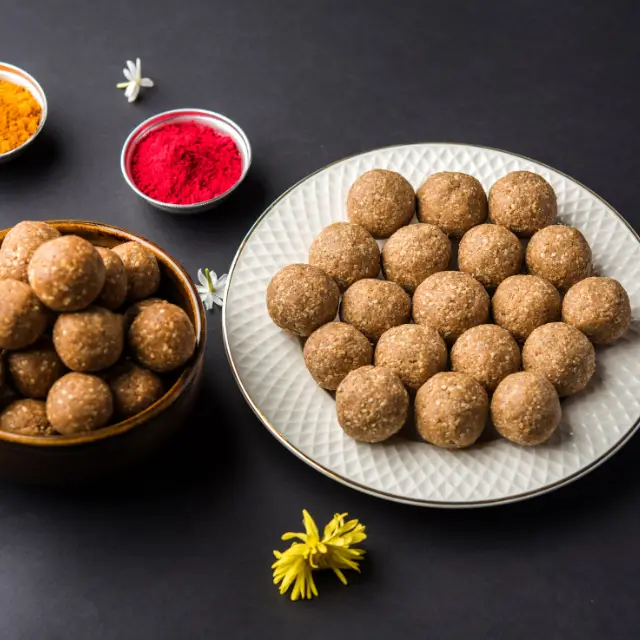
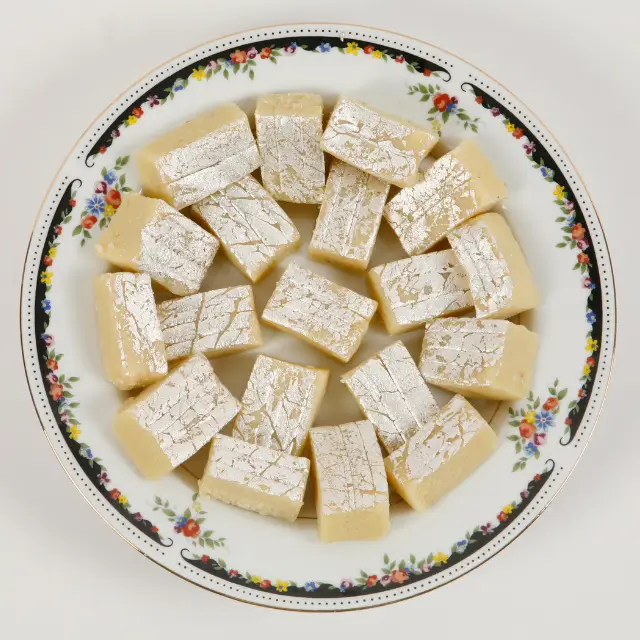
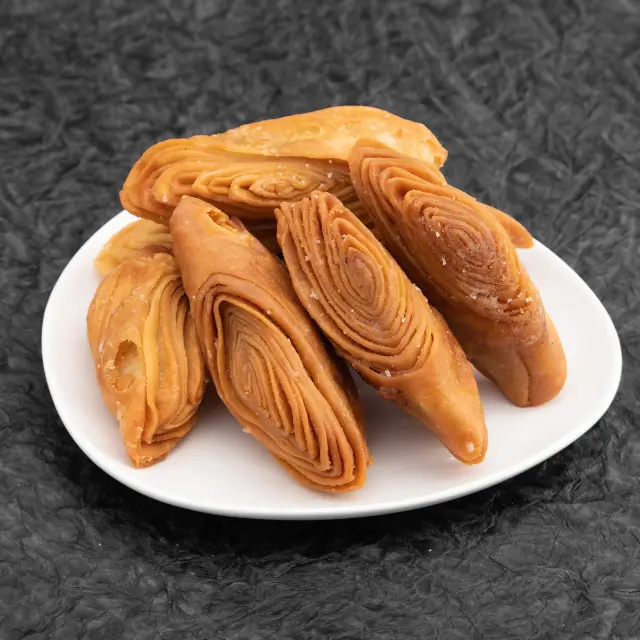
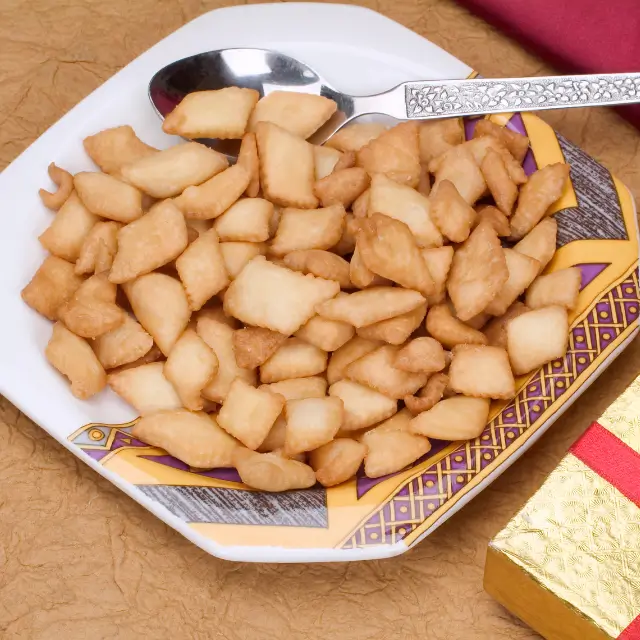
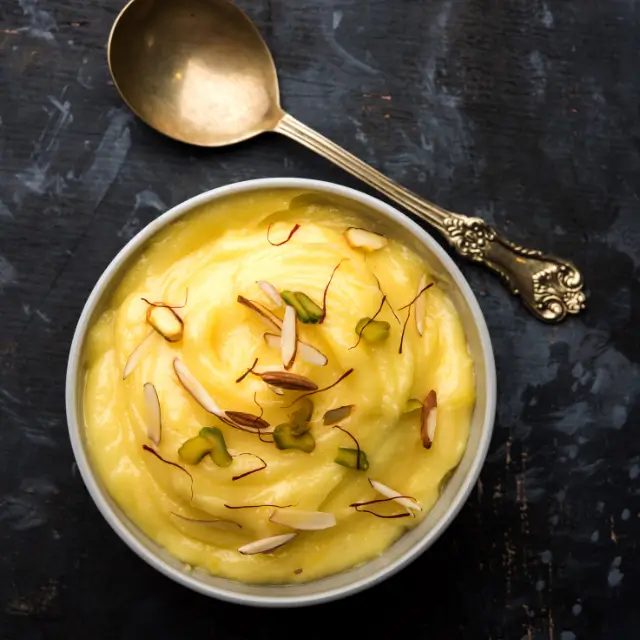

Maharashtra’s tapestry of sweets unfolds like a journey through its varied landscapes. The coastal Konkan region whispers tales of coconut palms in the sweetness of Puran Poli, a flatbread stuffed with a rich lentil and jaggery filling. Here, milk transforms into the creamy Shrikhand, flavoured with cardamom and saffron, a cool and refreshing treat for hot summer days.
Moving inland, the Deccan Plateau offers a taste of earthier delights. Jaggery takes centre stage in Sankarpali, the name itself meaning “thin strips,” a perfect description for these crunchy, twisted pastries. Besan Ladoo, golden spheres made from chickpea flour, jaggery, and ghee, offer a warm, comforting sweetness.
Festivals bring forth a vibrant display of flavours. Modak, the crescent-shaped dumpling with a sweet filling of coconut and jaggery, is a beloved offering to Lord Ganesha during Ganesh Chaturthi.
Diwali illuminates homes with the aroma of Karanji, half-moon-shaped pastries stuffed with a delectable mix of nuts, coconut, and jaggery. Aamrakhand, a seasonal delight, captures the essence of summer with the inclusion of Alphonso mangoes in the classic Shrikhand base.
The sweet dishes of Maharashtra are not just about indulgence; they are windows into the state’s cultural heritage. Each bite whispers stories of communities, traditions, and the ingenuity of using local ingredients to create lasting culinary legacies.
From the coastal coconut to the earthy jaggery, and the festive offerings to the everyday treats, Maharashtrian sweets are a testament to the state’s vibrant food culture, cherished for generations.
Traditional sweet dishes of Maharashtra
Beyond the beloved Puran Poli and Modak, the sweet dishes of Maharashtra’s repertoire boast a delightful array of regional specialities. For those seeking a textural contrast, the crisp “Karanji” beckons.
These crescent-shaped pastries, similar to Gujiya in other parts of India, hold a surprise within their flaky shells – a sweet and fragrant filling of coconut, nuts, and jaggery. Karanji adds a touch of elegance to festive occasions like Diwali.
For a taste of pure indulgence, look no further than “Shrikhand.” This creamy yoghurt-based dessert, flavoured with cardamom and saffron, is a quintessential Maharashtrian delight. During the mango season, the humble Shrikhand transforms into “Aamrakhand,” where the juicy sweetness of Alphonso mangoes takes centre stage. A scoop of Aamrakhand is a refreshing escape from the summer heat.
Venturing beyond the festive realm, “Anarsa” offers a unique combination of textures and flavours. This fermented rice cake, deep-fried to perfection, boasts a crispy exterior and a delightfully chewy centre. Anarsa is often coated with poppy seeds for an extra visual and textural flourish, making it a popular teatime treat.
Maharashtra’s sweet heritage extends beyond these examples. “Gulachi Poli,” a flatbread stuffed with a sweet and tangy tamarind filling, offers a surprising twist on traditional flavours. “Basundi,” a thick, condensed milk pudding flavoured with nuts and cardamom, is a decadent finale to any meal.
From the humble “Narali Vadi” – a coconut fudge bar studded with nuts and ghee – to the melt-in-your-mouth “Purancha Poli” – a variation of Puran Poli with a richer, nut-filled centre – each sweet tells a story of regional variations and culinary innovation.
Maharashtra’s traditional sweet dishes are a true celebration of local ingredients, cultural traditions, and the joy of sharing delicious treats with loved ones. They are a testament to the state’s vibrant food culture, offering a glimpse into the lives and traditions of its people.
Famous sweets from different regions in Maharashtra
Each region of Maharashtra has its unique sweet dishes that reflect the local flavours and ingredients. In Mumbai, the bustling metropolis, you will find the iconic “Mumbai-style Falooda,” a refreshing dessert made with vermicelli, milk, ice cream, and a variety of toppings such as rose syrup and nuts.
In the Nagpur region, the “Santra Barfi” steals the show with its tangy and sweet flavours. Made with fresh oranges, condensed milk, and ghee, this barfi is a delightful combination of citrusy goodness and melt-in-your-mouth sweetness.
Following are the most favourite sweet dishes from Maharashtra:
Modak
Modak, a delectable dumpling from India, is a favourite across many regions. They hold special significance in Hinduism, particularly as an offering to Lord Ganesha, who is believed to be especially fond of them. Here’s a closer look at this delicious treat:
- Sweet Filling: The heart of a modak is its sweet and flavorful filling. This typically features grated coconut and jaggery, a type of unrefined cane sugar, offering a rich and subtly sweet taste. Some variations might include chopped nuts or raisins for added texture and flavour bursts.
- Soft Dough Shell: Encasing this delightful filling is a soft and fluffy shell. This is traditionally made from rice flour, though wheat flour can also be used. The dough is pliable and easy to work with, allowing for the creation of the signature modak shape.
- Steamed to Perfection: Unlike many dumplings that are boiled, modaks are typically steamed. This gentle cooking method preserves the delicate flavours of the filling and creates a soft and slightly chewy texture in the dough.
- The Art of Shaping: While moulds can be used, shaping modak by hand is a traditional art form. The dough is rolled into small discs, and a spoonful of filling is placed in the centre. The edges are then carefully brought together and pinched to form a distinctive pleated design, often resembling a teardrop or a small purse.
- A Festive Favorite: Modak is particularly popular during the Ganesh Chaturthi festival, a celebration dedicated to Lord Ganesha. Offerings of modak are a customary part of the puja (prayer ceremony) [1].
- Beyond Festivals: While modak holds special significance during festivals, they are also enjoyed year-round as a delicious and satisfying sweet treat. They can be enjoyed warm or at room temperature, and some variations might even be drizzled with a touch of honey or ghee for an extra layer of flavour.
Overall, modak is a delightful combination of textures and flavours. It’s a testament to the beauty of simple ingredients and traditional cooking techniques. Whether enjoyed for its religious significance or simply as a delicious sweet, modak is a true gem of Indian cuisine. This is one of the traditional and mostly offered in Prasadam kind of sweet dishes of Maharashtra.
Puran Poli
Puran Poli is a sweet flatbread treat from Maharashtra, India. It’s a delightful combination of textures and flavours.
- Sweet Filling (Puran): The star of the show is the Puran, a sweet stuffing typically made with lentils (often chana dal or Bengal gram) cooked and mashed together with jaggery for sweetness. Cardamom and other spices like nutmeg and fennel seeds add a warm, fragrant touch.
- Flatbread (Poli): The outer layer is a soft flatbread made from whole wheat flour or a combination of whole wheat and all-purpose flour. Ghee, a clarified butter, is often used for kneading the dough, adding a rich flavour.
Puran poli is a delicious indulgence enjoyed on its own or paired with a lentil-based savoury dish like katachi amti for a complete meal. It’s also a staple during festivals like Diwali, Ganesh Chaturthi, and Holi. Another one of the sweet dishes of Maharashtra that is offered in every ceremonial offering and served with Ghee.
Shrikhand
Shrikhand is a traditional sweet dish originating from the Indian subcontinent, particularly popular in Gujarati and Marathi cuisine [1]. It’s a creamy and flavorful dessert made with just a few key ingredients:
- Strained Yogurt: The base of shrikhand is thick, strained yoghurt, often referred to as “hung curd” or “chakka” in Marathi. This is achieved by suspending yoghurt in cheesecloth and allowing excess whey to drain, resulting in a concentrated and protein-rich yoghurt with a slightly tangy flavour.
- Sweetness & Spice: Sugar is added to the strained yoghurt to create a perfectly balanced sweetness. Cardamom powder, a common spice in Indian desserts, is included for a warm, aromatic touch. Some recipes might also incorporate saffron, a luxurious spice that elevates the shrikhand with its subtle floral aroma and vibrant colour.
- A Rich & Creamy Treat: The mixture is whisked thoroughly until smooth and creamy. The thickness of shrikhand can vary depending on preference, but it generally has a soft and spreadable consistency, similar to thick pudding or cheesecake filling.
- Garnishes Galore: Shrikhand is often garnished with chopped nuts like pistachios or almonds for added texture and visual interest. Other variations might include chopped fruits, edible rose petals, or even a drizzle of honey.
- A Versatile Dessert: Shrikhand is a delicious dessert on its own, enjoyed chilled for a refreshing sweet treat. It’s also a common accompaniment to puris (deep-fried flatbreads), creating a delightful contrast between the creamy sweetness and the crispy, savoury puris.
- Simple Yet Special: Shrikhand’s beauty lies in its simplicity. The preparation involves minimal ingredients and straightforward steps, making it a perfect dessert for any occasion. Whether served as a festive treat or a casual sweet snack, shrikhand is sure to impress with its creamy texture and delightful flavours.
Karanji
Karanji, a jewel from Maharashtra, India, is a delightful sweet that packs a punch of flavour and texture in every bite. Here’s a breakdown of what makes it so special:
- Crispy Shell: Encasing the delicious filling is a flaky and golden brown outer shell. This is typically made with a simple dough of wheat flour or all-purpose flour, sometimes with the addition of ghee (clarified butter) for richness.
- Sweet & Fragrant Filling: The magic lies within. Karanji boasts a sweet and fragrant filling, traditionally made with a combination of grated coconut and chopped nuts like almonds or cashews. Warm spices like cardamom and sometimes even a pinch of nutmeg add depth and complexity to the flavour profile.
- Variations Galore: While the classic combination reigns supreme, there’s room for creativity. Some variations might include poppy seeds for a delightful textural contrast or raisins for a burst of sweetness and chewiness.
- The Art of Shaping: The dough is rolled out thinly, and then shaped into circles. A spoonful of the delectable filling is placed in the centre, and the edges are carefully sealed to form a crescent moon shape – the signature of a karanji.
- Golden Perfection: Once filled and shaped, the karanjis are deep-fried in hot oil until they reach a golden brown perfection. This process creates a delightful textural experience – the satisfying crunch of the exterior gives way to the soft and flavorful filling inside.
- Warm or Room Temperature: Enjoy karanji warm or at room temperature. They are perfect on their own, offering a delightful burst of sweetness and contrasting textures in every bite. But they can also be drizzled with honey or served alongside a dollop of yoghurt for an extra layer of flavour.
- A Festive Favorite: Karanji is a popular sweet treat during festivals like Diwali and Ganesh Chaturthi, adding a touch of sweetness to the celebratory spirit.
Overall, Karanji is a delicious and versatile sweet that showcases the beauty of simple ingredients and traditional cooking techniques. It’s a guaranteed crowd-pleaser, offering a delightful combination of contrasting textures and a symphony of sweet and fragrant flavours.
Aamras
Aamras, a staple in Maharashtrian cuisine, is a vibrant and simple ode to the king of fruits, the mango. Here’s what makes it special in Maharashtra:
- Seasonal Celebration: Aamras shines in the summer months, perfectly capturing the essence of mango season. When mangoes are at their ripest and sweetest, Maharashtrians turn them into this delightful dessert.
- Pure Mango Delight: Unlike some desserts that use mangoes as an accent, aamras lets the fruit take centre stage. Perfectly ripe mangoes are mashed or blended into a smooth, luscious puree. The sweetness comes primarily from the mangoes themselves, with sugar or jaggery added sparingly to enhance the natural flavour.
- Traditional Pairing: In Maharashtra, aamras is most often enjoyed alongside hot puris, and deep-fried flatbreads. This creates a delightful textural contrast – the soft, sweet mango puree is a perfect counterpoint to the crispy, savoury puris. Dunking puris into aamras is a beloved way to enjoy the dessert, creating a burst of flavour and texture in every bite.
- Simple Variations: While the core recipe is straightforward, some Maharashtrian households might add a touch of cardamom powder for a hint of warmth or a pinch of saffron for a touch of luxury. A splash of milk or cream can be incorporated for a richer texture, but the emphasis remains on the pure mango flavour.
Aamras is more than just a dessert; it’s a way for Maharashtrians to celebrate the bounty of the summer season and savour the deliciousness of perfectly ripe mangoes. It’s a simple yet satisfying treat that showcases the region’s love for fresh, seasonal ingredients.
Anarse
Anarse is a sweet, flaky Indian treat originating from Maharashtra and Bihar [1]. It’s a popular dish around Diwali, the festival of lights, and other special occasions. Here’s what makes anarse special:
- Unique Ingredients: The base of anarse is rice flour, giving it a light and slightly chewy texture. It’s sweetened with jaggery, a type of unrefined cane sugar, and often flavoured with cardamom for a warm touch.
- Fermentation Process: Traditionally, anarse dough undergoes a fermentation process for several days. This enhances the flavour and creates a slightly tangy undertone. However, some modern recipes skip this step.
- Crispy on the Outside, Soft on the Inside: Anarse is typically deep-fried in ghee (clarified butter) until golden brown. This results in a delightful textural contrast – a crispy, flaky exterior giving way to a soft and slightly chewy interior.
- Variations in Shape and Toppings: Anarse can be shaped into flat rounds or small balls. Poppy seeds are a common topping, adding a delightful textural contrast and a nutty flavour. Some variations might also include chopped nuts or other spices.
- A Labor of Love: While delicious, preparing anarse can be a time-consuming process, especially with the traditional fermentation step. This adds to its significance during festivals and special occasions.
Overall, anarse is a delightful treat that combines unique flavours and textures. It’s a delicious reminder of Maharashtrian and Bihari culinary traditions.
Besan Ladoo
Besan Ladoo, literally translating to “gram flour ball,” is a delightful Indian sweet originating from nearly every region, but with slight variations [1]. Here’s a breakdown of this classic dessert:
- Simple Ingredients: The core of Besan Ladoo is gloriously simple. Gram flour (besan), also known as chickpea flour, is roasted in ghee (clarified butter) until fragrant and golden brown. This forms the base of the ladoo.
- Sweetness & Flavor: Sugar or powdered sugar is added for sweetness, and cardamom powder provides a warm, aromatic touch. Some variations might include chopped nuts or other spices for additional flavour and texture.
- Textural Delight: The key to a perfect Besan Ladoo lies in the roasting process. The ghee and besan are roasted together until the besan reaches a golden brown colour and releases a nutty aroma. This not only develops flavour but also helps bind the ingredients together, creating a soft and slightly crumbly texture.
- Easy to Shape: Once cool, the mixture is shaped into small balls by hand. No fancy moulds are needed! This makes Besan Ladoo perfect for creating bite-sized treats for any occasion.
- A Versatile Treat: Besan Ladoo is a popular offering during festivals like Diwali and Holi, but it’s also enjoyed year-round as a sweet snack or dessert. It’s a delicious way to enjoy the simple flavours of roasted gram flour and ghee, and the variations allow for customization to individual preferences.
In essence, Besan Ladoo is a testament to the beauty of Indian sweets – simple ingredients, delightful flavours, and a focus on texture.
Sheera
Sheera, also known as Suji Halwa in some regions, is a traditional Indian sweet dish enjoyed throughout the country with some regional variations [1]. Here’s a closer look at this delicious pudding:
- Semolina Star: The heart of Sheera is semolina, also known as rava or sooji. This coarse flour made from wheat is roasted in ghee (clarified butter) until golden brown, releasing a nutty aroma.
- Sweet & Creamy: Milk and sugar are then added, creating a creamy and sweet base. The sweetness can be adjusted to your preference, and some variations might use jaggery instead of sugar for a more complex flavour.
- Flavorful Touches: Cardamom powder is a common addition, infusing the Sheera with a warm, aromatic touch. Other spices like saffron or nutmeg can also be included for a touch of luxury.
- Nuts & Dried Fruits: For added richness and texture, chopped nuts and dried fruits like raisins or cashews are frequently included. These add pops of flavour and visual interest.
- Texture Variations: Sheera can be enjoyed in a range of textures. Some recipes aim for a very smooth and creamy pudding, while others prefer a slightly coarser texture with a bit more bite from the roasted semolina.
- A Versatile Treat: Sheera is a popular breakfast dish in South India, often served alongside savoury options like upma or poha. It also shines as a dessert after a meal or as a sweet snack. It’s a simple yet satisfying dish that showcases the versatility of semolina.
- Regional Variations: While the core ingredients remain similar, different regions in India might have their own spin on Sheera. For example, Maharashtrian Sheera, sometimes called God Sheera, might be slightly richer with more nuts and milk.
Overall, Sheera is a delightful Indian dessert that’s simple to prepare yet bursting with flavour and texture. It’s a testament to the deliciousness that can be achieved with basic ingredients and a touch of culinary creativity.
Basundi
Basundi, a creamy and decadent delight, is a popular dessert originating from Western India, particularly loved in Maharashtra, Gujarat, and some South Indian states like Karnataka. Here’s what makes basundi so special:
- Sweetened Milk Magic: At its core, basundi is essentially thickened and sweetened milk. Full-fat milk is simmered patiently on low heat, allowing it to reduce by half. This slow-cooking process concentrates the milk’s natural sweetness and creates a rich, smooth texture.
- Sugar Rush: Once the milk has been reduced, sugar is added to create a perfectly balanced sweetness. The amount of sugar can be adjusted to your preference, allowing you to customize the intensity of the dessert.
- Aromatic Touch: Cardamom pods are a common flavouring for basundi, adding a warm and fragrant touch. Some recipes might also incorporate saffron, a luxurious spice that elevates the dessert with its subtle floral aroma and vibrant colour.
- Contrasting Textures: Basundi can be enjoyed warm or chilled. When warm, it has a smooth and slightly thick consistency, similar to condensed milk. Chilled basundi takes on a thicker, fudgier texture, offering a delightful textural contrast.
- Festive Favorite: Basundi is a popular dessert during festivals like Diwali and Ganesh Chaturthi. It’s also a common sight in thali meals, often served alongside savoury dishes for a sweet and satisfying finish.
- Simple Yet Versatile: Despite its rich flavour, basundi is surprisingly simple to prepare. It requires minimal ingredients and just a bit of patience for the slow cooking process. You can also find quicker versions made with condensed milk, offering a convenient alternative.
Basundi is a delicious example of how simple ingredients can be transformed into a truly decadent treat. Its versatility and rich flavour profile make it a beloved dessert across Western India and beyond.
Amrakhand
Amrakhand, literally translating to “mango delight” in Hindi, is a vibrantly creamy and refreshing dessert originating from western India, particularly popular in Maharashtra and Gujarat [1]. It’s a delightful symphony of textures and flavours that celebrates the king of fruits – the mango.
- Creamy Canvas: The base of Amrakhand is thick, strained yoghurt (hung curd), similar to Greek yoghurt. This provides a luxuriously smooth and slightly tangy canvas for the sweet mango flavours to shine.
- Sweet Mango Magic: Perfectly ripe mangoes are the star of the show. They are either mashed or pureed into a smooth consistency, capturing their natural sweetness and vibrant fruitiness.
- Sweetness on Your Terms: While the natural sweetness of the mangoes is a highlight, a touch of sugar or powdered sugar is often added for a more pronounced sweetness. The amount can be adjusted to your preference.
- Aromatic Delights: Cardamom powder is a classic addition, infusing the Amrakhand with a warm and inviting aroma. Saffron, a luxurious spice, can also be included for a touch of floral elegance and a beautiful golden hue.
- Textural Play: Chopped nuts like pistachios or almonds are frequently added for a delightful textural contrast. The creamy yoghurt and smooth mango puree are beautifully complemented by the satisfying crunch of the nuts.
- A Versatile Treat: Amrakhand can be enjoyed on its own, savouring the interplay of sweet and tangy flavours. It’s also a perfect accompaniment to puris (deep-fried flatbreads), creating a delightful contrast between the creamy sweetness and the crispy, savoury puris.
- Simple Yet Splendid: Amrakhand’s beauty lies in its simplicity. The preparation involves minimal ingredients and straightforward steps, making it a perfect dessert for any occasion.
Overall, Amrakhand is a delightful treat that celebrates the deliciousness of fresh mangoes and creamy yoghurt. It’s a testament to the power of simple ingredients and a touch of creativity in creating a truly satisfying dessert experience.
Ghavale Kheer
Ghavale Kheer, a traditional Maharashtrian dessert, is a unique and flavorful take on the classic Indian rice pudding. Here’s what makes it special:
- Sweet and Savory: Unlike many Kheer recipes that focus solely on sweetness, Ghavale Kheer embraces a delightful balance of sweet and savoury flavours. This is achieved by incorporating chopped vegetables like carrots, beets, and sometimes even green beans.
- Creamy Base: Similar to other kheer varieties, Ghavale Kheer uses rice as its base. The rice is cooked in milk until creamy, creating a smooth and comforting foundation for the other ingredients.
- Fruity Twist: A unique element of Ghavale Kheer is the addition of chopped fruits like mango or apple. This adds a refreshing touch and a burst of sweetness that complements the savoury vegetables.
- Aromatic Spices: Cardamom and other warm spices like nutmeg and cloves are common additions, infusing the kheer with a delightful aroma and depth of flavour.
- Ghee for Richness: Ghee (clarified butter) is often used for cooking the vegetables and sometimes even for flavoring the kheer itself. This adds a touch of richness and a nutty aroma.
- A Festival Favorite: Ghavale Kheer is a popular dessert during festivals like Gauri Ganesha, a celebration dedicated to Lord Ganesha and his consort, Gauri. However, its unique flavour profile makes it enjoyable any time of year.
- A Culinary Adventure: Ghavale Kheer offers a delightful departure from the typical sweet kheer. It’s a testament to the adventurous spirit of Maharashtrian cuisine, where sweet and savory flavors come together in perfect harmony.
If you’re looking for a kheer experience unlike any other, Ghavale Kheer is a must-try. Its unique combination of ingredients and flavors is sure to tantalize your taste buds and leave you wanting more.
Amba Poli
Amba Poli is a delicious and delightful sweet treat originating from Maharashtra, India. It’s a perfect way to preserve and enjoy the taste of mangoes even when they’re not in season. Here’s what makes Amba Poli special:
- Seasonal Celebration: Made with the essence of summer – ripe mangoes – Amba Poli is traditionally prepared during mango season, allowing you to capture the fruit’s sweetness at its peak.
- Simple Ingredients: The beauty of Amba Poli lies in its simplicity. It requires just a few key ingredients: Alphonso mangoes (known for their sweetness and flavor), sugar, and sometimes a touch of cardamom powder for a warm, aromatic touch.
- Sun-Kissed Sweetness: The preparation involves blending or pureeing the mangoes to create a smooth pulp. This pulp is then spread thinly onto a clean surface, traditionally a plate or a special drying cloth. The key step is then letting the sun do its magic. The mango puree is sun-dried for several days, until it transforms into a thin, leathery sheet.
- Naturally Sweet: The sugar added to the mango pulp enhances the natural sweetness of the fruit. However, the amount can be adjusted to your preference. Some recipes might even omit sugar altogether for a completely natural treat.
- A Versatile Treat: Amba Poli can be enjoyed on its own as a chewy and sweet snack. It’s also a popular accompaniment to puris (deep-fried flatbreads), creating a delightful contrast between the sweet and chewy amba poli and the crispy, savoury puris.
- A Labor of Love: While the ingredients are simple, the preparation can be time-consuming due to the sun-drying process. This adds to the significance of amba poli, making it a special treat enjoyed during the mango season or gifted to loved ones.
Overall, Amba Poli is a delicious way to savour the taste of mangoes throughout the year. It’s a testament to the resourcefulness and culinary creativity of Maharashtrian cuisine, using simple ingredients and natural processes to create a delightful and long-lasting treat.
Chiroti
Chirote, a flaky and delightful pastry from Maharashtra and Karnataka, is a true celebration of texture and flavour. Here’s a breakdown of what makes it special:
- Layered Delight: The magic of Chirote lies in its multi-layered dough. Plain flour (maida) is used to create a base, which is then layered with clarified butter (ghee) and rice flour paste. This creates a beautiful layered effect when fried.
- Deep-Fried Perfection: Chirote is traditionally deep-fried in ghee or oil. This process transforms the layered dough into a golden brown and flaky pastry. The result is a delightful textural experience – a satisfyingly crisp exterior giving way to soft and airy layers within.
- Sweet or Savory: While some enjoy Chirote plain, it’s most often enjoyed with a touch of sweetness. This can be achieved by sprinkling the Chirote with powdered sugar or dipping it in a flavoured sugar syrup. Cardamom is a common flavouring for the syrup, adding a warm and aromatic touch.
- A Festival Favorite: Chirote is a popular sweet treat during festivals like Diwali and weddings. It’s a delightful addition to any celebratory occasion.
- Simple Yet Satisfying: Despite its beautiful layered appearance, Chirote is surprisingly simple to prepare. The ingredients are readily available, and the process involves rolling and layering the dough before frying.
- Variations Across Regions: While the core recipe remains similar, Chirote might have slight variations depending on the region. Some variations might incorporate semolina flour for an added textural element. The sweetness level can also be adjusted to individual preferences.
Overall, Chirote is a delightful treat that showcases the beauty of simple ingredients and traditional cooking techniques. It’s a guaranteed crowd-pleaser, offering a delightful textural contrast and a touch of sweetness for any occasion.
Til Gul
Til Gul, also known as Tilgul Ladoo or Ellu Bella in some regions, is a simple yet significant sweet treat originating from India. It holds special importance during the Makar Sankranti festival, which marks the beginning of the harvest season. Here’s what makes Til Gul special:
- Seasonal Significance: Traditionally enjoyed during Makar Sankranti, Til Gul celebrates the bounty of the harvest and the transition into longer, sunnier days. It’s a time for families and communities to come together and share in the joy of the season.
- Symbolism of Auspiciousness: Til Gul carries symbolic meaning. “Til” translates to sesame seeds and “Gul” translates to jaggery, both representing prosperity and sweetness. Exchanging Til Gul with greetings of “Tilgul ghya, God God bola” (Marathi for “Take Til Gul, speak sweetly”) signifies good luck and well wishes for the coming year.
- Simple Ingredients: The beauty of Til Gul lies in its simplicity. It requires just two core ingredients – sesame seeds (“til”) and jaggery (“gul”). The sesame seeds are roasted until fragrant and then combined with melted jaggery to create a sweet and nutty mixture.
- Variations Galore: While the classic combination reigns supreme, some variations might include additional ingredients like peanuts, cardamom powder, or even chopped dry fruits for added flavour and texture.
- A Textural Delight: The contrasting textures are a key part of Til Gul’s appeal. The roasted sesame seeds add a satisfying crunch, while the jaggery creates a chewy and slightly sticky base.
- Easy to Shape: The mixture is often shaped into small balls or laddoos by hand. No fancy moulds are needed! This makes Til Gul a perfect treat to prepare with family and friends, fostering a sense of togetherness during the festive season.
- A Healthy Treat: Til Gul is not just delicious, it’s also considered a healthy option. Sesame seeds are a good source of protein, healthy fats, and essential minerals, while jaggery offers natural sweetness and a touch of iron.
Overall, Til Gul is more than just a sweet treat; it’s a symbol of celebration, good luck, and the start of a new season. Its simplicity, deliciousness, and cultural significance make it a cherished part of the Makar Sankranti festivities.
Shankarpali
Shankarpali, also known as shakkarpara, murali, khurma, lakdi mithai, or simply mithai, is a delightful Indian sweet snack originating from western India, particularly popular in Maharashtra, Gujarat, and Karnataka [1]. Here’s a breakdown of its essence:
- Sweet & Flaky Delight: Shankarpali is a crispy, diamond-shaped (or sometimes rectangular) fried pastry that offers a delightful combination of textures and flavours. The exterior is a flaky and golden brown shell, crafted from a simple dough made with all-purpose flour (maida), ghee (clarified butter), and sometimes semolina.
- Sweetness on Your Terms: The magic lies within. Shankarpali boasts a mildly sweet filling, traditionally made with sugar or powdered sugar. The sweetness level can be adjusted to your preference for a more subtle or pronounced taste.
- Aromatic Touch: A sprinkle of cardamom powder is a common addition, infusing the shankarpali with a warm and inviting aroma. Some variations might also include a pinch of saffron for a touch of floral elegance.
- The Art of Frying: The shaped dough pieces are deep-fried in hot oil until they reach a golden brown perfection. This process creates the signature crispy exterior that contrasts beautifully with the slightly sweet filling inside.
- A Versatile Treat: Shankarpali is a popular tea-time snack and a delightful accompaniment to festive occasions like Diwali and Ganesh Chaturthi. It can be enjoyed on its own or drizzled with a touch of honey for an extra layer of sweetness.
- Simple Yet Satisfying: Despite its beautiful golden facade, shankarpali is surprisingly simple to prepare. The ingredients are readily available, and the process involves rolling out the dough, shaping it, and frying it until golden brown.
Overall, shankarpali is a delightful treat that showcases the beauty of simple ingredients and traditional cooking techniques. It’s a guaranteed crowd-pleaser, offering a delightful textural contrast and a touch of sweetness for any occasion.
Naaral Barfi
Naaral Barfi, also known as Coconut Barfi, Kobbari Barfi, Copra Pak, or Tengai Barfi, is a delightful and traditional Indian sweet originating from various regions across the country. It’s a delicious way to celebrate the flavours and textures of coconut. Here’s a breakdown of what makes it special:
- Simple Ingredients: The beauty of Nariyal Barfi lies in its simplicity. It requires just a few key ingredients: freshly grated coconut (or desiccated coconut), sugar (or jaggery for a more complex flavour), milk, and sometimes nuts or cardamom powder.
- Sweetness & Texture: The combination of coconut and sugar creates a delightful sweetness that’s perfectly balanced. Depending on your preference, the sweetness level can be adjusted. The texture can also vary depending on the cooking time. Shorter cooking results in a softer barfi, while longer cooking creates a firmer, more fudge-like texture.
- Aromatic Touch: Cardamom powder is a common addition, infusing the barfi with a warm and inviting aroma. Some variations might also include a pinch of saffron for a touch of floral elegance and a vibrant yellow colour.
- Variations Galore: While the core recipe remains similar, there are regional variations. Some recipes might use condensed milk for a richer and creamier texture. Others might include chopped nuts like cashews or pistachios for added flavour and textural contrast.
- Easy to Make: No fancy moulds needed! The cooked mixture is simply poured into a flat tray and allowed to cool and solidify. Once set, it’s cut into squares or diamond shapes for a delightful and satisfying sweet treat.
- A Versatile Treat: Nariyal Barfi is a popular sweet for any occasion. It can be enjoyed as a tea-time snack, a festive dessert, or even gifted to loved ones. It’s a crowd-pleaser that’s sure to satisfy those with a sweet tooth and a love for coconut.
Overall, Naaral Barfi is a testament to the deliciousness that can be achieved with simple ingredients and traditional cooking techniques. It’s a delightful and versatile treat that showcases the beauty of coconut in all its glory.
Ingredients used in sweet dishes of Maharashtra
Maharashtra’s sweet treats go beyond simply satisfying a craving. The traditional ingredients employed are a symphony of flavours and textures, each playing a vital role in creating the final masterpiece.
Jaggery, the unrefined hero, takes centre stage. Unlike processed sugar, it offers a complex sweetness with hints of caramel and molasses. This not only elevates the taste but also adds a touch of warmth to dishes like “Sankarpali” and “Besan Ladoo.” For those seeking health benefits, jaggery is a natural source of minerals and antioxidants, making these sweets a guilt-free indulgence (well, almost!).
Coconut, another regional star, adds a touch of paradise. Freshly grated or dried, it lends a creamy texture and a subtle sweetness to “Puran Poli” and “Shrikhand.” Beyond taste, coconut adds a textural contrast, offering a delightful chew against the soft dough or creamy base.
In “Narali Vadi,” the hero ingredient takes centre stage, transformed into a fudge bar studded with nuts and held together by clarified butter (ghee).
Spices like cardamom and saffron play a supporting, yet crucial, role. Cardamom, with its warm, citrusy notes, cuts through the sweetness and adds a touch of complexity. Saffron, the “king of spices,” adds a touch of floral elegance and a vibrant yellow hue to sweets like “Shrikhand” and “Basundi.”
Nuts like cashews, almonds, and pistachios add a delightful textural crunch and a touch of richness. They are not just mere decoration; they elevate the visual appeal and provide a satisfying bite.
Crushed or slivered, they add a welcome contrast to the soft fillings or creamy textures. In some sweets, like “Purancha Poli,” a variation of the classic Puran Poli, nuts take centre stage, forming a luxurious filling within the sweet flatbread.
Maharashtra’s sweet treats are a testament to the state’s ability to transform simple ingredients into culinary masterpieces. Each bite tells a story of tradition, resourcefulness, and the joy of creating deliciousness with what nature provides.
Popular festivals and their associated sweet dishes
Festivals play a significant role in Maharashtra’s culinary traditions, and each celebration is incomplete without its signature sweet dish. During Ganesh Chaturthi, the festival dedicated to Lord Ganesha, “Modak” takes centre stage. This sweet dumpling, believed to be Lord Ganesha’s favourite, is prepared in large quantities and distributed as a prasad (offering) to devotees.
Diwali, the festival of lights, is synonymous with “Karanji,” a crescent-shaped pastry filled with a sweet mixture of coconut, jaggery, and nuts. These festive sweet dishes not only add joy to the celebrations but also bring people together in the spirit of togetherness and happiness.
Unique and lesser-known sweet dishes of Maharashtra
While Maharashtra is home to many famous sweet dishes, there are also hidden gems that are lesser-known but equally delicious. One such delicacy is the “Anarsa,” a deep-fried pastry made with rice flour and coated with sesame seeds.
Anarsa is traditionally prepared during the festival of Diwali and is enjoyed as a crispy and sweet snack. Another unique sweet dish is the “Shrikhand,” a creamy dessert made by straining yoghurt and sweetening it with sugar and flavoured with cardamom and saffron. This refreshing dessert is often served chilled and is a popular choice during festive gatherings.
Famous sweet shops in Maharashtra
If you want to savor the authentic flavours of Maharashtra’s sweet dishes, there are several renowned sweet shops that have been serving these delicacies for decades. One such establishment is “Chitale Bandhu Mithaiwale” in Pune, known for its mouthwatering “Bakarwadi” and “Pedha.”
In Mumbai, “Mithaiwala” is a go-to destination for a wide range of sweets, including the iconic “Mumbai-style Falooda” and “Malpua.” These sweet shops not only offer a delectable variety of sweets but also provide a glimpse into the culinary traditions and heritage of Maharashtra.
Sweet dishes of Maharashtra: Make At Home
If you are inspired to try your hand at making Maharashtra’s sweet dishes at home, here are a few tips to help you achieve the perfect flavours and textures. First and foremost, use high-quality ingredients to ensure the authenticity and taste of the dish. Pay attention to the measurements and proportions mentioned in the recipes, as they play a crucial role in achieving the desired results.
Don’t be afraid to experiment with flavours and ingredients to add your own personal touch to the dish. Lastly, practice patience and precision while preparing these sweet dishes, as they require attention to detail and a gentle hand to bring out their true essence.
Health benefits of sweet dishes of Maharashtra
While sweet dishes are often associated with indulgence, many of Maharashtra’s traditional sweets offer health benefits as well. Jaggery, a key ingredient in many sweet preparations, is a healthier alternative to refined sugar. It is rich in iron and antioxidants and aids in digestion.
Coconut, another commonly used ingredient, is packed with essential nutrients and healthy fats that promote brain function and boost the immune system. Additionally, the use of nuts such as almonds and cashews adds protein and healthy fats to these desserts, making them a wholesome choice when consumed in moderation.
Conclusion
Maharashtra’s sweet dishes are a reflection of the state’s rich culinary heritage and diverse cultural influences. From the traditional flavours of Puran Poli and Modak to the innovative creations found in Mumbai’s bustling streets, every sweet dish tells a story of Maharashtra’s vibrant food culture.
Whether you have a sweet tooth or simply enjoy exploring different cuisines, indulging in Maharashtra’s sweet dishes is a delightful experience that will leave you craving more. So, the next time you visit this enchanting state, be sure to savour the flavours of its sweet delicacies and immerse yourself in the world of Maharashtra’s culinary delights.

